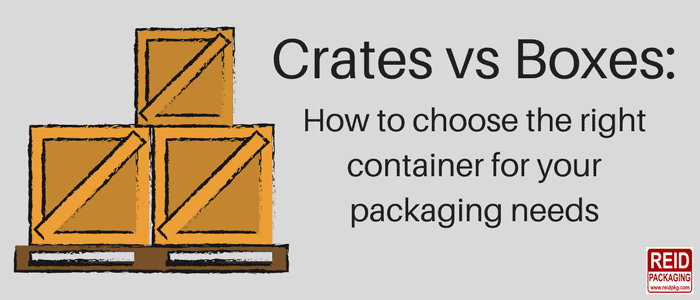Crates vs. Boxes: How to choose the right container for your packaging needs
There’s one question that perennially occurs to people considering what kind of packaging they need for transportation or distribution purposes:
What is the difference between a crate and a box?
Believe it or not, this is a difficult question to answer. But we’re going to give it a try, as it will bring us to talk about some of the important distinctions to make when considering what kind of packaging will best suit your needs.
Semantics
Crate: a large box used to store or transport something
Box: a space or a container, usually with a hinged lid
The words are incredibly similar. A box is a more general term and a crate is a more specific term; a crate is usually a box, but a box is not necessarily a crate. Many people think that a box is always made out of cardboard, but that is not necessarily true. Many crates use cardboard components, and boxes can be made of wood or plastic just as much as cardboard. We also might assume that crates have “cleats” (the dimensional lumber, say 1×4’s, attached to the plywood panels) and are assembled using nails or screws, while boxes might use adhesive or folds. But this, again, is a misconception.
Getting Specific
Well, if “box” and “crate” are not useful identifiers, then what are the distinctions that should be made when considering the correct packaging for the job? When we get more specific about the kind of packaging we need, then we can begin to find the terms that match our needs.
Here are some useful terms that will help to specify the kind of container that will perfectly match your needs.
- Collapsible – When a crate or box is collapsible it is much easier to store. Most stock cardboard boxes are collapsible, but if you’re making a wooden container, then special consideration needs to be made for collapsing the container and then re-building it. The ability to easily store a container can make it much more useful for certain applications. A cleated crate assembled using Klimp style fasteners instead of nails or screws makes for an excellent collapsible crate.
- Hinged – A hinged container means that the top of the container is on a hinge. This makes certain packaging processes easier and makes it easy to open and close the container frequently.
- Reusable – A re-usable container can go on multiple trips and still maintain its integrity. If many trips are needed, then the added costs of creating a reusable container will outweigh the costs of building new containers.
- Mil Spec – A Mil Spec container is one that adheres to the specifications of the US Military. Any container for products sold to the Department of Defense need to adhere to Mil Spec guidelines.
- Export – Export crates are able to be sent across national borders without problem. It means that the materials used in building the container have been treated to remove harmful pests that can cause problems when imported to other regions. Export containers get a “bug stamp” to certify that they comply with ISPM-15 regulations and can cross borders.
- Stackable – It’s important to consider how the containers will be stored and transported, and what kind of footprint they should have. Making containers stackable can solve big problems down the road, when you need to move many containers at the same time. Stacking containers often includes palletizing them as well, which should be considered when designing or requesting containers. But will each crate need its own pallet base or can several be banded to a single pallet? Do the stacked crates need to interlock in some way to prevent them from shifting in transit?
These are just some of the important considerations to take into account when deciding the kind of packaging that is best for your purposes. Please contact us if you have a specific need and we’ll be glad to suggest packaging solutions that perfectly match your needs. It might be a “box” or it might be a “crate” but it will always be a great packaging solution!

